Most of the web developers used to search; what is on page search engine optimization? What is SEO? How to do SEO? What are the on-page SEO techniques? What is a link builder? Which on page SEO factors need to consider? And so on...
As a rule of thumb, as the best SEO examples the first thing that comes to mind when planning your SEO page efforts are building a respectable and proper backlink portfolio - inbound links from external domains that point to your homepage or a page within your website. The local SEO marketing and local SEO services usually used to find out your on page SEO report to determine your needs and online SEO requirements.
Also as a rule of thumb, internet marketers will often prioritize this type of activity & on page SEO tutorial since it requires little to no previous knowledge of web technology and SEO on-page optimization. But when it comes to achieving the best possible results that make you listed in best SEO websites, one must always start by cleaning one's own house.
Here is a checklist of the key things you have to keep in mind about on-page SEO optimization before even thinking of off-site optimization. Learn SEO strategies and techniques & how to increase SEO without any SEO company. Your every web pages and your site must get that high ranking in SERP with high-quality content by using quick best SEO optimization practice basics.
However, to improve SEO ranking much more, today I'm are going to discuss the On-Page SEO Checklist which is one of the major factors you can't ignore to optimize search engine & to build a perfect SEO page that forces the search engine to index it quick in SERP.
Keyword optimization: Targeting highly-effective SEO keywords
1. Title
Title is the most important factor in SERP, That will help to write better and SEO-friendly titles for your blog pages.
A 'SEOMoz' study has clearly shown that the position of the highly effective SEO keyword in a title plays as a ranking factor - and having the keywords in the middle or in the back caused the results to rank lower.
2. SEO-friendly permalinks
You don't want to start your URLs with numbers and unnecessary symbols that would give unclear signals to a search engine crawler.Avoid horrible URLs at any costs, for.ex. yourdoman(.)com/p=4452368, since Google stated that first 3-5 words in a URL are given the most weight. So it's better to change your permalinks for SEO Friendly URLs.
Content optimization & Search Engine Success Factors
1. Headline tags
Most popular CMS platforms, like WordPress, automatically embed the title into the H1 tag (i.e. headline) but be careful of this, since some blogger templates and WordPress themes override this function.Always double check in the code if the H1 tag is added to your title. Your title should be in 'H1' tag whereas subheadings are in 'H2' tags.
2. Keyword placement
Don't forget to implement the keyword in the first 200-350 words of the article.Having a keyword in the first paragraph gives a signal to the search engine that the content is actually about the keyword.
3. Outbound links
Using quality backlinks to relevant sources and authority sites such as .gov, .org sites or Wikipedia links helps to improve your PageRank.Boosting traffic, SEO enhancement, branding, increase domain authority, these are the major advantages of implementing Backlink Strategy.
4. Multimedia
Why your visitors bounce from your website or business blog? Written content text can’t always get you far enough. Enriching your content with multimedia such as images, videos, and graphs can greatly influence the bounce rate of your site and increase the time spent by visitors on your site.5. Headline modifiers
Using title modifiers such as "Fix", "Best", "Tut", "Popular", "How to", "Guide", or "Review" can help you rank higher for the long tail versions of your keywords.If you used to read the catchy advertising headlines examples you will find that the headlines are what sell your quality content. Your post headlines are representatives of the contents you have written on the page.
Your headlines lead your content in search engines (SERP).
The catchy newsletter titles always impact and convert your searcher into the reader.
6. Length of the Content
Although still debatable, the length of the content can be used to determine the search rank.The absolute minimum word count recommended in order to achieve any form of quality is 800 words, but there are studies claiming that you should aim for at least 1500-1800 words when targeting very competitive keywords.
Optimize web pages for SEO to rank better in Google SERP
1. Speed, give me what I need
If your site loads more than 3 seconds, you are much more likely to lose your visitor. Not only that, but loading speed is the most important ranking signal for most search engines.You must improve the loading speed by compressing your multimedia, choosing a good web hosting plan, using a CDN (content delivery network) etc.
2. Social sharing buttons
Online presence is almost nothing without good social media coverage. Social shares are also an important ranking signal, and prominent and well-designed social sharing icons can help increase the social shares up to 700%.3. Cut down the bounce rate
A bounce is an occurrence of a visitor quickly leaving your site. That might happen for a number of reasons and Google uses Google toolbar, Chrome browser, and Google Analytics data to control and analysis the bounce rate of your every web page.To lower your bounce rate, you could work on improving the internal link structure on your site, writing a good copy, and investing in a clean site theme that would work in tone with your branding design.
4. Sprinkle the LSI Keywords
These are the keywords that are related to the keywords you are searching for and can be found at the bottom of your Google search page.LSI keywords (Latent Semantic Indexing) are synonyms used to define a page’s relevancy, and possibly even quality. You required to know current SEO techniques which help you understand what are LSI keywords used for & how to find it for better SEO & drive more organic traffic to your website.
5. HTML stuffed content
Sometimes the Google crawlers have greater difficulty on crawling when looking at what is relevant or what is not; since they spend a lot of time roaming through your HTML code. For example, having a paragraph style or inline group tag that repeats itself each time you enter a different piece of code can work very negatively towards the readability of your site.
While designing your website you must choose SEO-Friendly themes that helps search crawlers to identify each part of your website & index it quickly in SERP.
If you're already doing, at least, a couple of these things, then your site might be on a good run. Do your best to implement as many of this advice and techniques before, or at least, simultaneously with your off-site SEO campaign.
As you see, all you need is a bit of time, patience, and some skills with HTML to significantly improve your site's performance and boost your rankings in the process.
What do you think about new SEO techniques and trends and how you rank in search engines, do share your thoughts via comment section shown below.






Posting Komentar
Posting Komentar